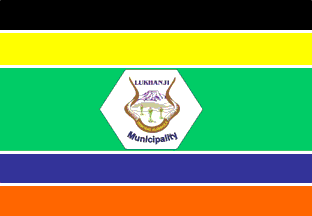 image by Bruce Berry, 13 Dec 2006
image by Bruce Berry, 13 Dec 2006
Last modified: 2007-06-30 by bruce berry
Keywords: lukhanji |
Links: FOTW homepage |
search |
disclaimer and copyright |
write us |
mirrors
 image by Bruce Berry, 13 Dec 2006
image by Bruce Berry, 13 Dec 2006
See also:
Lukhanji Municipality is located in the Eastern Cape Province of South Africa and comprises the six former transitional councils of Queenstown (which itself comprised Queenstown, Mlungisi and eZibeleni), the Queenstown Transitional Rural Council (TRC), a portion of Cacadu / Glen Grey TRC , the Hewu TRC, the Whittlesea / Sada TLC and a portion of the Cathcart TRC. The new municipality was established on 05 December 2000 following the re-organisation of local government in South Africa. Queenstown is the commercial, administrative and educational centre of a prosperous farming district.
The layout of Queenstown reflects its original objective as a defensive stronghold for the frontier area and has a most unusual design. There is a central hexagonal area where canon or rifle fire could be directed down six thoroughfares radiating from the centre. The canon sites have now been replaced with gardens and a central fountain was the dominant feature. A striking abstract sculpture replaced the fountain as part of the town's 150th anniversary.
A new municipal flag and coat of arms were adopted on 05 July 2003. The flag comprises five horizontal stripes of black, yellow, green, blue and red, all fimbriated in white. The central green stripe is double the width of the others and has the new municipal arms in white in the centre.
ec-lk.jpg) scan by
Bruce Berry, 13 Dec 2006
scan by
Bruce Berry, 13 Dec 2006
The symbolism of the colours is given as follows:
Black for the people and continent of Africa; Yellow for warmth and prosperity; Green for tranquility and fertility and refers to the agricultural basis of the economy; Blue is for peace and hope; and Red is for energy, passion, courage and action.
Within the Arms the mountain is viewed from Zingqutu. This is a symbol of strength and is a local landmark and serves as a visual reminder of the Lukhanji's location. The blue of the mountain is separated by the brown of the land symbolising the soil, and represents the rural nature of the area. The supporters are two Kudu horns and represent the natural heritage of the area.
The Aloe Ferox (Bitter Aloe) is an indigenous succulent plant whose fleshy leaves have several uses such as for traditional medicine and fodder during times of drought. It is characteristic of the area and symbolises perseverance, strength and the evergreen tradition of freedom.
The Arms incorporate
the colours of the former Queenstown emblem (red and yellow) as well as the
motto from Whittlesea. This alludes to continuity between the past and
present. The motto, in Xhosa, is "Umanyano Ngamandla" and means "Unity is
Strength". The new municipal Arms can thus be said to represent the Lukhanji
spirit - building for the future based on the best traditions of the past.
Bruce Berry, 13 Dec 2006